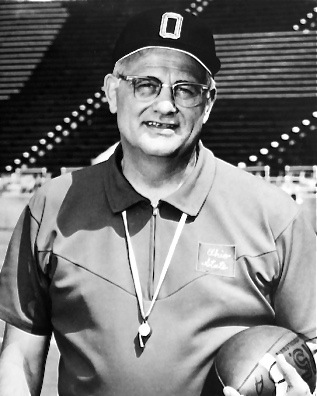Because of football, college sports is one school year from its greatest upheaval in now over three decades of constant change. And no one can stop it or the changes that will follow.
 He knows changes aren’t permanent…
He knows changes aren’t permanent…
But change is…
Those lyrics aren’t particularly profound or prophetic. We all know change is inevitable. But those words do represent the rebellious and independent spirit of the disruptive and trend-setting Big Ten that Rush sang about in “Tom Sawyer.”
Being west of the Mississippi isn’t new for the Big Ten. But in our hop-on-a-plane society, that line of demarcation is something I’ve rarely heard anybody refer to much since, well, Mark Twain wrote about Tom and Huck’s adventures. We’re just part of one big continental community.

Veteran columnist Jeff Gilbert writes Ohio State football and OHSAA sports for Press Pros Magazine.com.
But college sports traditionally operated in geographic silos. This land is our land, and that land is your land. That is until Texas and Oklahoma schools became attractive to the SEC, and West Coast schools became attractive to the Big Ten.
The Big Ten, and its disposition to grow and conquer, sees something valuable in that great expanse stretching to the Pacific Ocean not seen since Thomas Jefferson’s great land purchase. And TV partners are spending a lot more than Jefferson did. The Mississippi River now cuts right through the heart of the Big Ten, and college football will change more drastically than ever in 2024.
If you hate everything about the Big Ten stretching from sea to shining sea, hold onto 2023. Embrace the season. Make it your own. Because this is only the beginning of bigger changes being stacked upon bigger changes. More on that later.
For now …
 Reminisce about the sanctity of old conference alignments. Smile at the thought of the Big 2 and the Little 8 and the 10-year war. Woody and Bo wouldn’t quite understand why all of this is necessary. If it helps, tell yourself those legends are turning over in their graves with the same vigor they stormed the sidelines.
Reminisce about the sanctity of old conference alignments. Smile at the thought of the Big 2 and the Little 8 and the 10-year war. Woody and Bo wouldn’t quite understand why all of this is necessary. If it helps, tell yourself those legends are turning over in their graves with the same vigor they stormed the sidelines.
But remember when the college football landscape went through the upheaval of Penn State joining the Big Ten in 1990? Wow, the Big Ten stretched all the way into eastern Pennsylvania. That addition represented a shift in priorities ($$$$). Not enough to change the name of the league to the Big Eleven. Let’s not get crazy. It was jarring enough to include the 11 in the logo.
Did you like that change? Does it even matter now? That addition worked and raised the profile of the Big Ten, something most fans say they want in an attempt to compete with the hated SEC. If you thought adding Penn State was a good move, I won’t say you should have seen 2024 coming. But it was the start.
Thirty-three years later an addition of a close cousin like Penn State is like adding a deck to your backyard. Who would notice? But USC, UCLA, Oregon and Washington? Yeah, adding them to the Big Ten in 2024 and decimating the once-proud Pac-8, then Pac-10, then Pac-12 and now Pac-up-and-disappear, made more than a few headlines.

In his wildest dreams…Woody Hayes would have turned a deaf ear to the culture of modern football…that prioritizes the bottom line over books and life after football!
This is the final year of college football (and other college sports at least for now) resembling anything like what we (and when I say we, I mean those of us lived through the 10-year war, 9-3 Earle and maybe even the Cooper years) grew up with. Whether you love, hate or are indifferent to the effects on tradition, power programs like Ohio State are driving this bulldozer that began paving the way in 1990 when geography began not to matter.
And geography means absolutely nothing now. If you are an Ohio State football fan who likes to drive to road games, that painful backed-up traffic crawl to Penn State matters not to you now. That will feel like an easy drive compared to a trip to the West Coast every year. Sure, you will fly and maybe catch a refreshing nap at over 30,000 feet, but being a diehard fan just got more expensive, far more inconvenient, and just doesn’t feel like a league game.
It will be fun once, maybe twice, but a trip to L.A. ain’t the same in October as it is at New Year’s. And a trip to Eugene doesn’t sound fun at all. OSU fans won’t be quite the same scarlet presence in those venues that they are in such exotic places as Iowa City, State College and Ann Arbor.
College football has been a TV sport for a long time, which is why this is all happening. Now is the time to buy that 85-inch TV with surround sound with the money you’ll be saving by not venturing to the farthest points west of the Mississippi.
Remember when an OSU-USC game was preceded by the Tournament of Roses Parade? You have to be of a certain age to remember the Rose Bowl Game as something special. The Buckeyes will play in that stadium again when they travel to play UCLA next season. Of course, with the recent addition of the Ducks and Huskies, the Big Ten must redo its schedule for next year, which could change OSU’s West Coast destination.
The Bucks might also play in Pasadena in a national semifinal this year if they can navigate road trips to Notre Dame, Wisconsin and Michigan. But the Rose Bowl against even a Pac-12 team (that league should actually be good this year), isn’t what it used to be.
Naming the members of the Big Eighteen could be a good trivia question. But more likely the better one, years from now, will be who was in the Big Ten when it was actually 10 teams? This is the final year the league will resemble anything like what many of us grew up with.
This is also the final year of the four-team playoffs, and it took us so long, it seemed, to get here. We rejoiced (maybe you didn’t) when the decision was made to actually determine the champion on the field. It began with the two-team BCS system, but after a while that seemed so limited. The same thing happened again.
Next year 12 teams will be invited to the party. Hard to imagine a future without the Buckeyes being a regular participant, but the new paradigm of 2024 didn’t seem possible as recently as the COVID pandemic.
So this is it. College sports, which changes with the seasons, will see a whirlwind of change beginning this time next year. Of course, as we know, changes aren’t permanent, but change is. What’s next?
There are as many opinions and predictions as there will be teams in the Big Ten. No one could begin to imagine them all, but I have ideas (and certainly none are original to me) about a path forward that might make sense. Who can really know.
College sports’ next change could be to move football toward an alignment model that doesn’t necessarily align with the other sports. Football isn’t going back to a tidy geographic design. But, thousands are asking, why should athletes in other sports, who have more games to play and therefore more travel, suffer? They still must do this thing called going to class. Remember those NCAA-produced PSAs highlighting student-athletes who go pro in something other than sports? Apparently, not everyone does.
Some speculation foresees two super conferences (the Big Ten and SEC are well on their way) dominating college sports. Maybe basketball likes the super conference idea, but what’s the point of all sports being subjected to that. TV certainly isn’t a reason.

The quesion is…why does every other Big Ten sport have to change just for the sake of football?
The Big Ten is home to seven hockey teams, including Notre Dame, but the rest of Division I plays in hockey-only leagues. So why can’t the Big Ten be a 12- or 14-team conference to every sport except football and maybe basketball.
Why can’t the Pac-12 live on as the Conference of Champions with everything but football and maybe basketball? Probably because it makes too much sense.
The desire to change it all outweighs the desire to change only what demands change. Football will get more interesting. A super conference or two of 30 to 40 teams with 12 playoff spots available means more good TV games because one loss, or even two losses, will be less crippling.
And what if it means fewer or no Youngstown States and Western Kentuckys on the schedule. That would mean more compelling home games to watch. If that happens, maybe you won’t feel like you missed out so much by not figuring out how many layovers it takes to get to Eugene, Oregon.
The Big Ten and the SEC have made up their minds. Bigger is better. More good TV games means more TV dollars. But don’t ever think they’re finished changing. Because preceding the lyrics that began this discussion about changes not being permanent, but change is, are the emotions that drive all change.
Always hopeful, yet discontent……



